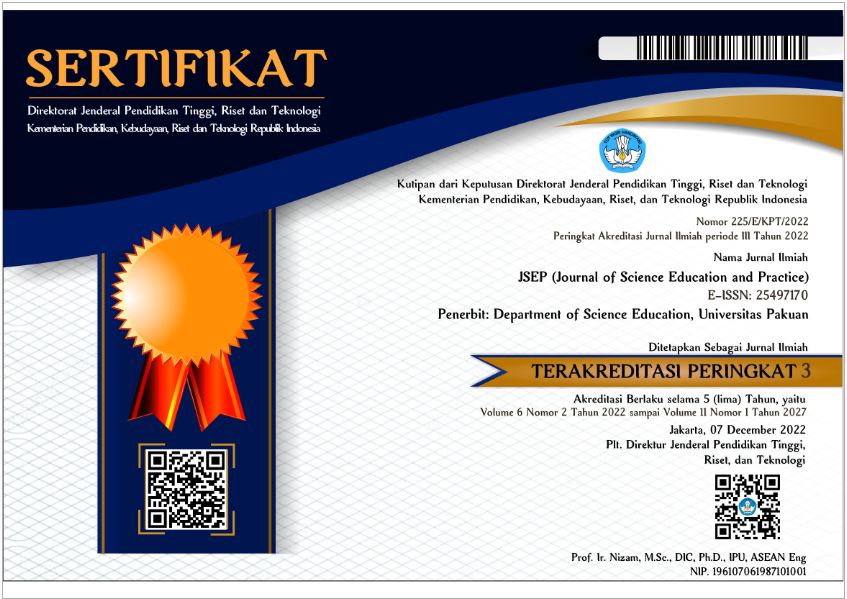ADDITIONAL MENU
Improving Student's Skills and Concept Understanding in Vibration and Waves with the Use of Visual Media Concepts on Students
Abstract
Keywords
References
Anggereini, E., Septiani, M., & Hamidah, A. (2021). The effect of guided inquiry learning models using the help of student activity sheet on the knowledge competency of students in class xi of SMAN 1 Sungayang The effect of guided inquiry learning models using the help of student activity sheet on the know. Journal of Physics. https://doi.org/10.1088/1742-6596/1940/1/012120
Brame, C. J. (2016). Effective Educational Videos : Principles and Guidelines for Maximizing Student Learning from Video Content. CBE—Life Sciences Education •, 16. https://doi.org/10.1187/cbe.16-03-0125
Cetin, I. (2020). Teaching Loops Concept through Visualization Construction. 19(4), 589609. https://doi.org/10.15388/infedu.2020.26
Chang, Y., Hu, K., Chiang, C., & Lugmayr, A. (2019). Applying Mobile Augmented Reality ( AR ) to Teach Interior Design Students in Layout Plans : Evaluation of Learning E ff ectiveness Based on the ARCS Model. Sensors.
Dasilva, B. E., & Ardiyati, T. K. (2019). Development of Android-Based Interactive Physics Mobile Learning Media ( IPMLM ) with Scaffolding Learning Approach to Improve HOTS of High School Students 1. Journal for the Education of Gifted Young Scientists, 7(September), 659681.
Dasilva, B. E., Kuswanto, H., Wilujeng, I., & Jumadi. (2019). SSP Development with a Scaffolding Approach Assisted by PhET Simulation on Light Refraction to Improve Students Critical Thinking Skills and Achievement of Science Process Skills SSP Development with a Scaffolding Approach Assisted by PhET Simulation on. Journal of Physics. https://doi.org/10.1088/1742-6596/1233/1/012044
Fajra, M., & Novalinda, R. (2020). INTERNATIONAL JOURNAL OF MULTI SCIENCE Project-Based Learning : Innovation To Improve The Suitability Of Productive Competencies In Vocational High Schools With The Needs Of The World Of Work. INTERNATIONAL JOURNAL OF MULTI SCIENCE, 1(7), 111.
Febianti, Y. N. (2014). PEER TEACHING (TUTOR SEBAYA) SEBAGAI METODE PEMBELAJARAN UNTUK MELATIH SISWA MENGAJAR Yopi. Edunomic.
Gleason, B. L., Peeters, M. J., Resman-targoff, B. H., Karr, S., Mcbane, S., Kelley, K., Thomas, T., & Denetclaw, T. H. (2011). An Active-Learning Strategies Primer for Achieving Ability-Based Educational Outcomes. American Journal OfPharmaceutical Education, 75(9).
Guan, N., Song, J., & Li, D. (2018). On the advantages of computer multimedia-aided English teaching. Procedia Computer Science, 131, 727732. https://doi.org/10.1016/j.procs.2018.04.317
Gunawan, Harjono, A., Hermansyah, & Herayanti, L. (2019). GUIDED INQUIRY MODEL THROUGH VIRTUAL LABORATORY TO ENHANCE STUDENTS SCIENCE PROCESS SKILLS ON HEAT CONCEPT. Cakrawala Pendidikan, 38(2), 259268. https://doi.org/10.21831/cp.v38i2.23345
Hadi, R. (2015). The Integration of Character Values in the Teaching of Economics : A Case of Selected High Schools in Banjarmasin. 8(7), 1120. https://doi.org/10.5539/ies.v8n7p11
Herlina, M., Lubis, R., & Agustiana, U. (2022). Hasil Belajar Siswa Dengan Menggunakan Pembelajaran Tipe STAD Dan Pembelajaran Tipe GI. Jurnal Pendidikan Dan Pembelajaran Biologi, 6(1), 93100.
Herodotou, C., Sharples, M., Gaved, M., Kukulska-Hulme, A., Rienties, B., Scanlon, E., & Whitelock, D. (2019). Innovative Pedagogies of the Future: An Evidence-Based Selection. Frontiers in Education, 4(October), 114. https://doi.org/10.3389/feduc.2019.00113
Leonard, M.M., M. P., Wibawa, P. D. B., & Suriani, P. D. (2019). MODEL DAN METODE PEMBELAJARAN DI KELAS.
Mathai, S., & Ramadas, J. (2009). Visuals and Visualisation of Human Visuals and Visualisation of Human. October 2014, 3741. https://doi.org/10.1080/09500690802595821
Munawwarah, I., & Khaldun, I. (2016). The Effect of Constructivist Learning Using Scientific Approach on Mathematical Power and Conceptual Understanding of Students Grade IV The Effect of Constructivist Learning Using Scientific Approach on Mathematical Power and Conceptual Understanding of S. Journall of Physics: Conference Series. https://doi.org/10.1088/1742-6596/693/1/012019
Peranginangin, S. A., Saragih, S., & Siagian, P. (2019). Development of Learning Materials through PBL with Karo Culture Context to Improve Students Problem Solving Ability and Self-Efficacy. 14(2), 265274.
Ramos, J. L., Cattaneo, A. A. P., Jong, F. P. C. M. De, & Gonçalo, R. (2021). Pedagogical models for the facilitation of teacher professional development via video-supported collaborative learning . A review of the state of the art. Journal of Research on Technology in Education, 0(0), 124. https://doi.org/10.1080/15391523.2021.1911720
Rutten, N., Joolingen, W. R. Van, & Veen, J. T. Van Der. (2012). Computers & Education The learning effects of computer simulations in science education. Computers & Education, 58(1), 136153. https://doi.org/10.1016/j.compedu.2011.07.017
Sari, S., Taufiq, A. U., & Tahir, M. Y. (2018). Pengembangan Bahan Ajar Riddle Story Book Materi Sistem Rangka Manusia Kelas XI SMU. 6, 6579.
Simanjuntak, M. P., Hutahaean, J., Marpaung, N., & Ramadhani, D. (2021). Effectiveness of problem-based learning combined with computer simulation on students problem-solving and creative thinking skills. International Journal of Instruction, 14(3), 519534. https://doi.org/10.29333/iji.2021.14330a
Smetana, L. K., & Bell, R. L. (2012). International Journal of Science Computer Simulations to Support Science Instruction and Learning : A critical review of the literature. International Journal of Science Education, September 2014, 3741. https://doi.org/10.1080/09500693.2011.605182
Suendarti, M., & Liberna, H. (2018). The Effect of I-CARE Learning Model on the Students Metacognition. Journal of Mathematics Education, 3(2), 4046. https://doi.org/10.31327/jomedu.v3i2.439
Supena, I., & Hariyadi, A. (2021). The Influence of 4C ( Constructive , Critical , Creativity , Collaborative ) Learning Model on Students Learning Outcomes. 14(3), 873892.
Tullis, J. G., & Goldstone, R. L. (2020). Why does peer instruction benefit student learning ? Original Article.
Wibowo, D. C., & Pelipa, E. D. (2018). Effect of Recitation Method to the Students Interest and Learning Results. Jurnal Studi Guru Dan Pembelajaran, 1(1), 1620.
DOI: 10.33751/jsep.v6i1.5689
 Abstract views : 508
Abstract views : 508
Refbacks
- There are currently no refbacks.
Copyright (c) 2022 JSEP (Journal of Science Education and Practice)

This work is licensed under a Creative Commons Attribution 4.0 International License.












